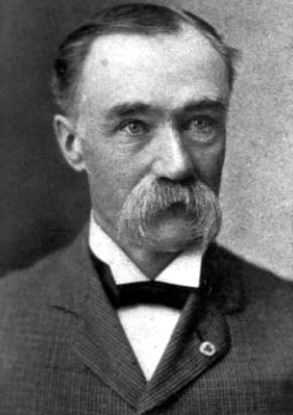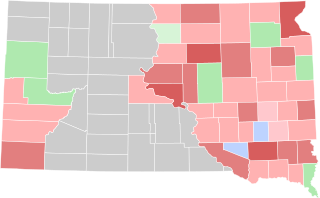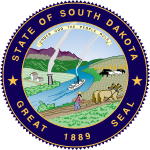
Presidential elections were held in the United States on November 3, 1896. Former Governor William McKinley, the Republican nominee, defeated former Representative William Jennings Bryan, the Democratic nominee. The 1896 campaign, which took place during an economic depression known as the Panic of 1893, was a political realignment that ended the old Third Party System and began the Fourth Party System.

The People's Party, usually known as the Populist Party or simply the Populists, was an agrarian populist political party in the United States in the late 19th century. The Populist Party emerged in the early 1890s as an important force in the Southern and Western United States, but declined rapidly after the 1896 United States presidential election in which most of its natural constituency was absorbed by the Bryan wing of the Democratic Party. A rump faction of the party continued to operate into the first decade of the 20th century, but never matched the popularity of the party in the early 1890s.

Daniel Lindsay Russell Jr. was an American politician who served as the 49th governor of North Carolina, from 1897 to 1901. An attorney and judge, he had also been elected as state representative and to the United States Congress, serving from 1879 to 1881. Although he fought with the Confederacy during the Civil War, Russell and his father were both Unionists. After the war, Russell joined the Republican Party in North Carolina, which was an unusual affiliation for one of the planter class. In the postwar period he served as a state judge, as well as in the state and national legislatures.
Fusion Party is a name for multiple political parties in United States history and more recently a Federal political party established in Australia. The different parties that used the name don't share any particular political positions; instead, confederations of people from disparate political backgrounds united around a common cause individual to their situation—often opposition to a common enemy—and used the name Fusion Party to reflect the aggregate nature of their new party.

Andrew Ericson Lee was an American politician who served as the third Governor of South Dakota.
The following table indicates the parties of elected officials in the U.S. state of Idaho:
The following table indicates the party of elected officials in the U.S. state of South Dakota:

The 1894 South Dakota gubernatorial election was held on November 6, 1894. Incumbent Republican Governor Charles H. Sheldon ran for re-election to a second term. Despite facing a thread of defeat at the Republican convention, Sheldon was renominated unanimously. In the general election, he faced Populist nominee Isaac Howe, a Spink County Judge; James A. Ward, the former state chairman of the South Dakota Democratic Party; and Prohibition nominee M. D. Alexander. The election was largely a replay of the gubernatorial elections of 1890 and 1892, with the Farmers' Alliance candidate placing second and the Democratic nominee placing a distant third. This time, however, Sheldon won an outright majority and the Democratic Party's vote share shrunk to just 11%, its worst performance in state history.

The 1892 South Dakota gubernatorial election was held on November 8, 1892. Incumbent Republican Governor Arthur C. Mellette declined to seek re-election to a third term. Former territorial legislator Charles H. Sheldon was nominated by the Republican Party as Mellette's replacement, and he faced former legislator Abraham Lincoln Van Osdel, a leader in the South Dakota Farmers' Alliance and the nominee of the Independent Party, along with Democratic nominee Peter Couchman, in the general election. The result was largely a replay of the 1890 election, with Sheldon winning by a large margin, but only a plurality, and Van Osdel taking second place over Couchman.

The 1896 South Dakota gubernatorial election was held on November 3, 1896. Incumbent Republican Governor Charles H. Sheldon declined to run for re-election to a third term. Former Secretary of State Amund O. Ringsrud was nominated as Sheldon's replacement at the Republican convention. Ringrud's main opponent was businessman Andrew E. Lee, who was nominated by a makeshift coalition of Populists, Free Silver Republicans, and Democrats. In the general election, Lee narrowly defeated Ringsrud, the first defeat for the Republican Party in a gubernatorial election since statehood.

The 1902 South Dakota gubernatorial election was held on November 4, 1902. Incumbent Republican Governor Charles N. Herreid ran for re-election to a second term. He faced former Watertown Mayor John W. Martin, the Fusion nominee who was listed as the Democratic nominee, in the general election. Herreid defeated Martin in a landslide to win his second term.

The 1900 South Dakota gubernatorial election was held on November 6, 1900. Incumbent Governor Andrew E. Lee, a Populist elected under Fusion with Populists, Free Silver Republicans, and Democrats, opted to run for Congress rather than for a third term. Former Sioux Falls Mayor Burre H. Lien won the Fusion nomination and ran against former Lieutenant Governor Charles N. Herreid. However, despite the closeness of the 1896 and 1898 elections, the Fusion's luck ran out; Herreid defeated Lien in a landslide to reclaim the office for the Republican Party.

The 1898 Wyoming gubernatorial election was held on November 8, 1898. Incumbent Republican Governor William A. Richards was a candidate for re-election, but he was defeated for renomination at the Republican convention, which instead nominated DeForest Richards. The Democratic Party joined forces with the Free Silver Republicans to jointly nominate former State Representative Horace C. Alger for Governor. The Populist Party, though reduced in influence from earlier elections, nominated E. B. Viall as its candidate. Though the election was closer than 1894, owing in large part to a dramatic reduction in the share of vote received by the Populist nominee, Roberts defeated Alger by a wide margin.

John L. Pyle was an attorney and politician from the state of South Dakota. A Republican, he was notable for his service as State's Attorney of Hand County (1886-1888) and state Attorney General (1899-1902).

United States gubernatorial elections were held in 1898, in 28 states, concurrent with the House and Senate elections, on November 8, 1898.

United States gubernatorial elections were held in 1896, in 32 states, concurrent with the House, Senate elections and presidential election, on November 3, 1896.

A general election was held in the U.S. state of Wyoming on Tuesday, November 6, 1894. All of the state's executive officers—the Governor, Secretary of State, Auditor, Treasurer, and Superintendent of Public Instruction—were up for election. The Republican Party, helped by the strong performance of the Populist Party, which operated as a spoiler to the Democratic Party, won back the governorship and improved its margin of victory in all other statewide offices.

A general election was held in the U.S. state of Wyoming on Tuesday, November 8, 1898. All of the state's executive officers—the Governor, Secretary of State, Auditor, Treasurer, and Superintendent of Public Instruction—were up for election. The Republican Party retained all of the offices up for election, though by reduced margins from 1894 as the Populist Party's performance decreased considerably.
From 1894 to 1900 the North Carolina Republican Party and the Populist Party collaborated via electoral fusion to compete against the North Carolina Democratic Party. This political coalition was dubbed Fusionism.

William Anderson Guthrie was an American lawyer and politician. Born in Chatham County, North Carolina, he attended the University of North Carolina at Chapel Hill and served in the Confederate States Army during the American Civil War. After the war, Guthrie married and moved to Fayetteville to practice law. He located his practice to Durham in 1884.


















